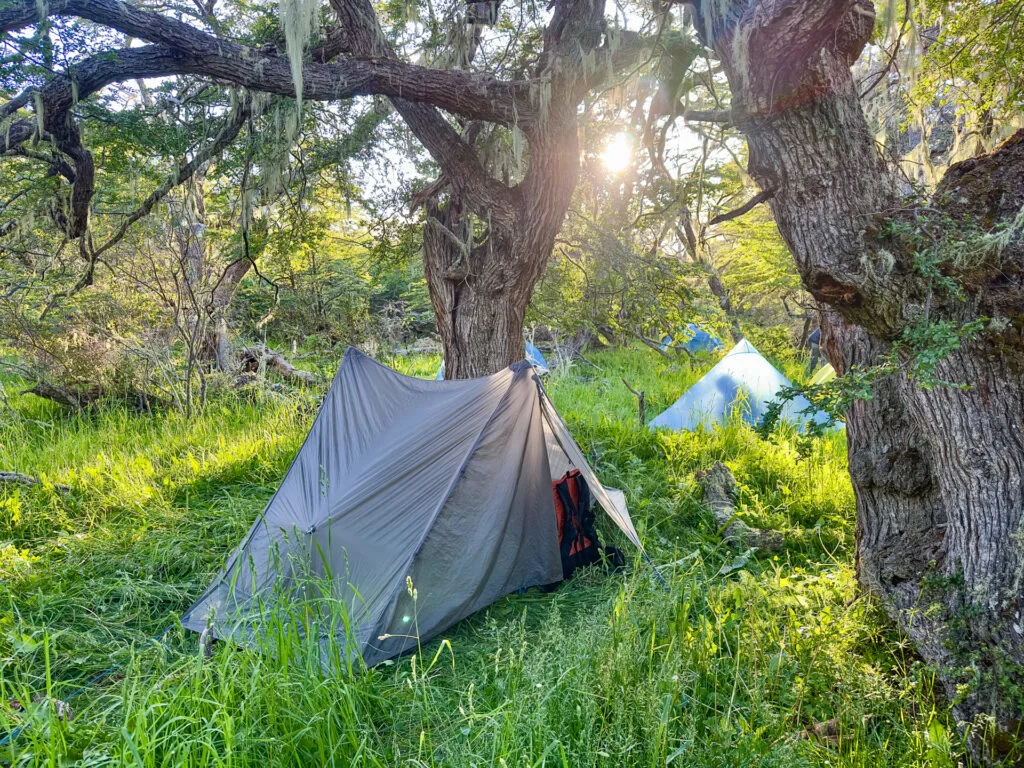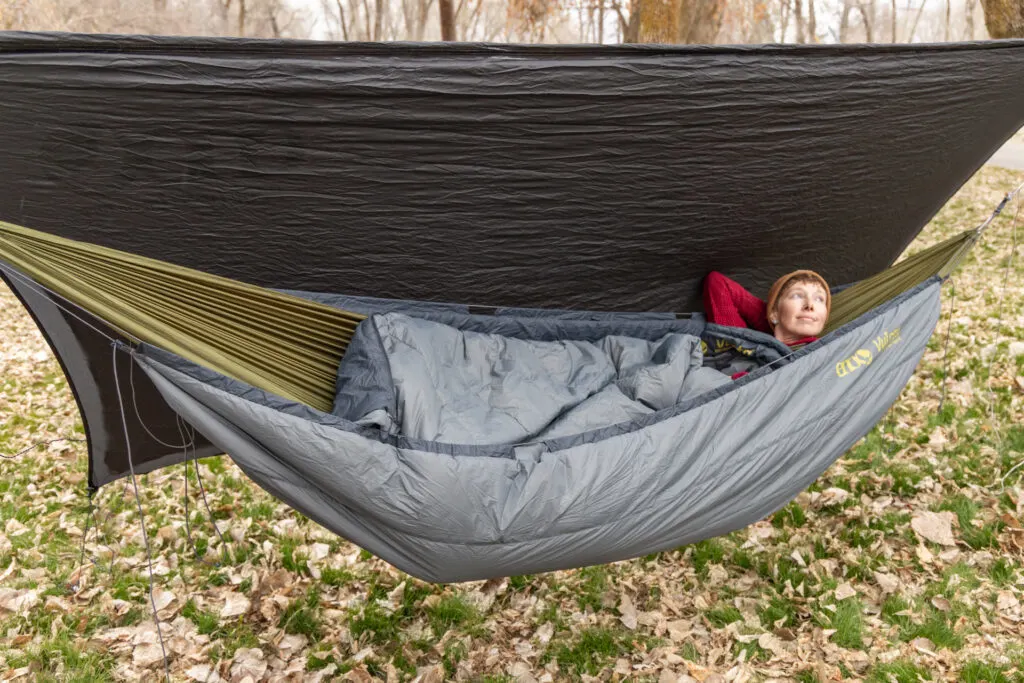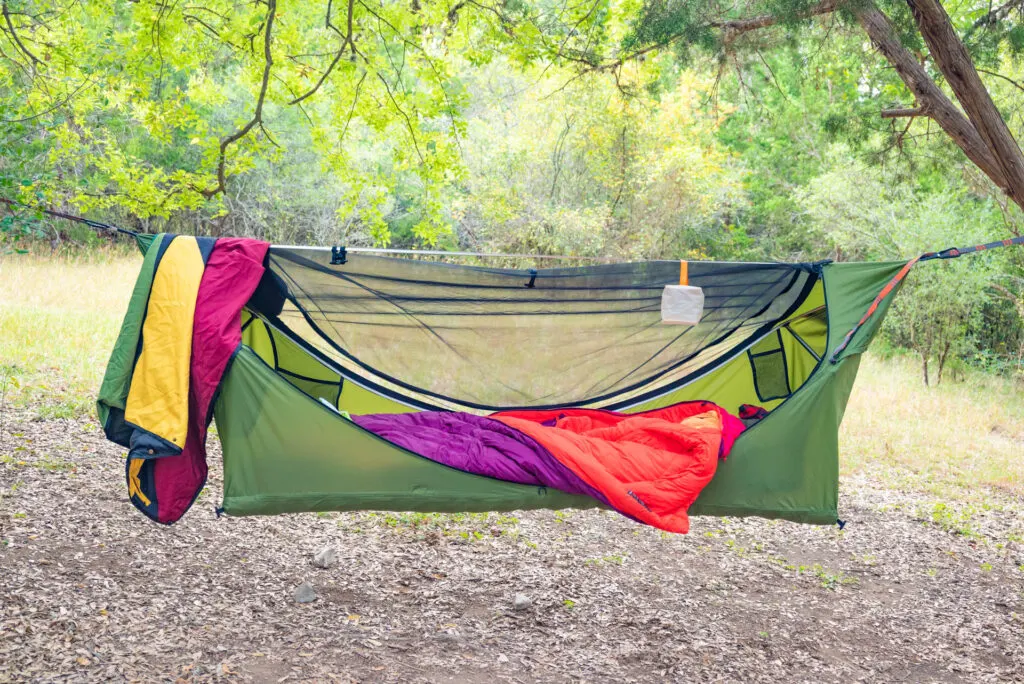REI Anniversary Sale May 16-26 - Up to 30% off plus 20% off member deals!
Thinking of swapping your tent for a hammock on your next camping or backpacking trip? Or are you new to this whole camping thing and trying to decide which sleep setup is going to provide the ultimate backcountry experience? Well, you’ve come to the right place. Because choosing between hammock camping and tent camping is…nuanced? They’re just different, OK? And offer very different experiences. Fortunately, in the battle of tent vs hammock, there are distinct pros, cons and insider tips to help you choose the ultimate sleep setup for your next outdoor adventure and we’re gonna break ’em down to help you make the right decision for you.

Tent Camping: Pros and Cons
Tents are the standard for the outdoor industry. There are tons of options, sizes and designs available.
Pros
- Less individual gear required in shoulder seasons: When tent camping, when temps drop, you don’t typically need to add more gear, you just need to upgrade to warmer gear.
- Often lighter: When considering a tent or hammock for backpacking, we’ve found tent camping to be slightly lighter in summer months and much lighter in the winter. Our summer tent setup complete with sleeping pad, bag and tent (our one-person Gossamer Gear The One), is 50oz. In shoulder season or winter, our UL tent setup weighs about 82oz (scroll down for hammock weight below).
- Sleep warmer in shoulder seasons: You likely won’t need to upgrade to a warmer bag or pad when tent camping for some shoulder-season camping, but you’ll have to break out warmer gear, possibly an insulated sleeping pad AND an underquilt a lot sooner if you’re sleeping in a hammock (more on why you sleep colder in a hammock in this article).
- Familiar sleeping position: While sleep comfort is largely personal preference, tent camping allows you to sleep in a familiar position, flat like in their bed at home. There’s no learning curve. You know how to sleep this way.
- Easier to find a place to pitch: The harsh truth of the matter is that the world is designed for tent camping. Campgrounds are designed for tent camping. Even in the backcountry (depending on where you live, of course) it’s often easier to find a flat spot to pitch a tent than two trees spaced perfectly far apart with no brush under your bum. Plus, lots of national and state parks don’t want you hanging hammocks at all.
- Easier to stash gear: Provided your tent has a vestibule or two, it’s often easier to stash gear in a tent to keep it safe and dry than in a hammock.
Cons
- Hotter in summer: In a tent, even with the fly off, you’re on the ground and at best feeling minimal airflow through the mesh sides of your tent. In a hammock, you’re suspended above the ground in thin fabric, so any breeze touches every part of your body, which helps keep you cool.
- Sleeping discomfort: Many folks find it hard to find the right sleeping pad that’s the perfect balance of comfort and support (and that they won’t roll off of). This, combined with the fact that you’re sleeping on a maximum of 4″ of air on the hard ground can be uncomfortable for some.
- You’ll be sitting and crawling on the ground: While we don’t mind sitting in a tent in the evening to hang and enjoy the atmosphere, climbing in and out every time you need to grab something or go to the bathroom can be annoying at best and for those with back or knee issues, painful at worst.
- Noisy entry and exit: Thanks to all the zippers and nylon on traditional tents, getting in and out, including in the middle of the night, and windy weather can mean lots of noise. So pack earplugs if you’re a light sleeper and traveling with a partner or a group.

Hammock Camping: Pros and Cons
Hammocks aren’t just for hanging in the backyard. They can elevate (literally and figuratively) every camping experience.
Pros
- No sleeping pad required in summer: At least in warm weather, you won’t need the extra space in your pack for a sleeping pad or have to fuss with inflating one every night. And most hammock camping kits like the Kammok Mantis come with everything you need for warm weather camping (hammock, straps, tarp, bug net).
- Potentially cooler in summer: When it’s truly hot and miserable outside, you may actually be more comfortable in a hammock. That’s because in addition to not having to lay on top of a sticky sleeping pad, you also benefit from airflow on all sides of your body.
- No pressure points: When sleeping in hammock vs tent, there are no pressure points like sleeping on the ground on a thin inflatable pad. Many people with back or shoulder issues especially find a hammock relieves some of the discomfort of sleeping on the ground.
- Can be pitched almost anywhere with a stand: While not a solution for backpacking, when car camping, a portable hammock stand like the ENO Nomad or the Kammok Swiftlet is super convenient and allows you to set up literally anywhere.
- Can double as a chair: No need to pack a camp chair if you’re bringing a hammock. It’s not just a sleeping surface, but a place to sit and a super comfy place to chill on lazy afternoons.
- Quiet: While a tarp can certainly snap in the wind, a taught pitch is often easier to accomplish in a hammock, which reduces noise. Also, since there are often no zippers to fuss with (unless you’re using a bug net with one), getting in and out is less disruptive in the middle of the night.
Cons
- More gear required in winter: When it’s cold, most people will need more than just a hammock. You’ll also need a bulky underquilt, insulated pad, and tarp to help keep you warm as opposed to just upgrading to warmer gear like you need to with tent camping.
- Gear is often heavier: If you’re comparing a streamlined ultralight backpacking sleep setup, what you need for tent camping will likely be lighter. Our summer hammock camping kit, the ENO SubLink Ultralight hammock system, was 57oz complete with a hammock, bug net, tarp and the same ultralight quilt. Add on a few more ounces if you want a larger 2-person hammock, which is more comfortable to sleep in. But the extra gear required for winter hammock camping is much heavier at 126oz. Weight matters if you’re backpacking, especially if you’re an ultralight backpacker.
- Potentially colder in winter: We did a whole breakdown on the science of staying warm while hammock camping in this article, but suffice it to say it’s easier to feel cold in a hammock than in a tent thanks to convective heat loss (which is the reason an underquilt is necessary). Under about 55-65ºF, you may start to notice a difference.
- Unfamiliar sleeping position: Some people find the subtle swaying and the slight curvature of a hammock hard to get used to. That said, if you’re looking for tips on how to sleep more comfortably in a hammock or how to lay flat in one, we have a video on that.
- Can be harder to find a place to hang: You may have to pour over campground photos, call ranger stations, and circle campgrounds just to find a site that would be suitable for a hammock. And the difficulty doubles if there’s more than one of you trying to hang a hammock. The only way to get around that is to also bring a hammock stand.
- Not much privacy: Hammocks don’t offer much privacy for changing, even with a tarp, so if staying in a crowded campground, you may have to find an alternative solution. And if you’re traveling with a partner you’ll be sleeping separately. (Whether that’s a downside or not is up to you.)

The Best of Both Worlds
If you still can’t decide between a tent vs hammock, allow us to introduce you to the concept of a lay flat camping hammock tent. These are pieces of gear that essentially offer you the best of both worlds: a mostly flat sleeping surface, often more privacy, places to store gear, and more (though they’re still often heavier). We’ve even reviewed a bunch of hammock camping tents.
- Tentsile Tree Tent: Designed for car camping, not backpacking, this massive tree tent is available for two, three or four people, hangs between three trees instead of two, is also a super comfy place to hang out, offers plenty of storage and space to sprawl out, and plenty of privacy. Read our full review of the Tentsile Connect here. There’s also a one-person backpacking hammock called the Una we reviewed.
- Haven Spectre: Only available for pre-order on Kickstarter in April 2025 (it’ll be available for purchase this September), the Haven Spectre is lightweight (just over 4lbs), uber comfy, comes with an insulated pad, offers lots of storage pockets, AND lets you lay flat. Read our review of the original Haven Tent here.
What hammock should you buy and which hammock is most comfortable? That’s up to you friend. Check out our reviews to help you decide.

Bottom Line: Tent vs Hammock Camping
So which one ya goin’ with? Did we help you decide? Did we miss any major pros or cons of either? Drop your thoughts in the comments! And remember not to base your decision on the number of pros and cons for each category, or on what friends and family think is the best option, but which one is right for you. Consider whether sleep position is more important to you than weight or if you’re OK sacrificing some privacy for a less stuffy summer night. Then whichever one you choose, get out there and wander on (and sleep well).
